Since July 1, 2010, the European Union has placed a ban on US imports of farmed (live and fresh) bivalve molluscks and certain marine invertebrates. The Food and Drug Administration (FDA) and the Directorate General for Health and Consumer Protection (DG SANCO) are working to resolve this equivalency issue.
Executive Summary
France is a major consumer and net importer of many seafood products. In 2008 France imported 1 million tons of fish and seafood from the world; of which, 38,830 tons was from the United States, valued at $223 million. This represents a four per cent value reduction from 2008 levels. US shrimp, scallops, salmon, and crab exports to France rose 37 per cent, 34 per cent, 13 per cent, and four per cent, respectively. US tuna and lobster exports dropped 90 and 27 per cent, respectively. Global Trade Atlas year-to-date statistics indicate that the 2010 outlook is favorable for increased consumption of seafood and fishery products.
On July 1, 2010, the European Commission Regulation allowing imports of farmed live and fresh molluscan bivalve and certain marine invertebrates from the United States expired, including oysters and roe-on scallops while excluding roe-off scallops. Both, FDA and DG SANCO are working to resolve the situation as quickly as possible. Until these products are again allowed to enter the port, The National Oceanic and Atmospheric Administration (NOAA) will not grant export health certificates.
The United States and France produce many of the same goods and services and export them to each other. Therefore, marketing products and services in France can bear some resemblance to marketing in the United States.
General Information
SITUATION AND OUTLOOK
France is a major seafood importer, as its domestic production is significantly lower than its total demand. In 2008, France’s trade deficit for seafood products was 742,181 tons, which was valued at nearly $4 billion. During this year, the United States was France’s 4th largest supplier of fishery and seafood products, after Norway, Spain, and the United Kingdom. The largest import groups include frozen scallops, Pacific Salmon, fresh/live lobster, and frozen groundfish. Frozen scallops have a strong presence in the market as France is one of the largest consumers of scallops in the European Union. Pacific salmon’s presence is also strong in the market, as the United States is the 4th largest supplier to France; however imports dropped in 2006, as France began to produce and export more of their own salmon. Fresh lobster and frozen groundfish’s import strength have remained relatively constant over the last four years.
Although the United States is the largest supplier of lobster to France, it is considered a luxury item. As the price of lobster increases (or as a consumer’s purchasing power decreases), less lobster is consumed, as can be seen by the drop in consumption between 2008 and 2009, when the world felt the economic crunch. The outlook for sales of high end US products will depend greatly on the recovery in the economy.
Largest Categories of US Seafood Products Imported by France, 2006 - 2009
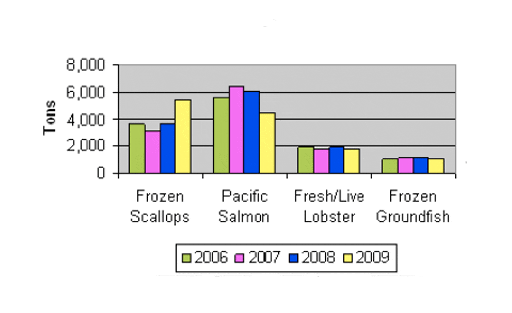
Fish and Seafood Production
In 2008, the fisheries and aquaculture section, including production and imports, of France sold 707,170 tons of seafood and fishery products which was valued at $2 billion. Of total production sold, 193,650 tons came from shellfish farming, 50,420 tons from fish farming, 161,800 tons from frozen landings, and 301,300 tons from fresh landings.
Figure 2.Fresh Landings Lead in Fisheries and Aquaculture Sold (tons)
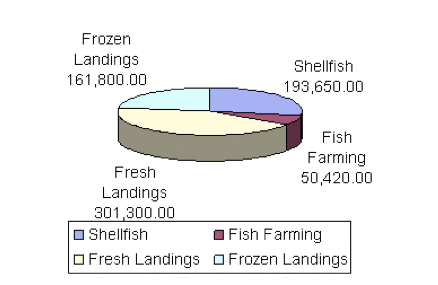
For fisheries production, there are 40 farm-sites spread across the coast of France. The farming techniques practiced at these farms are diverse including earth ponds with pumping and closed circuit, tidal marshes. Marine fish farms produced 8,000 tons of fish with a value of $62 million in 2008. The main fish species farmed in France included bar (3,900 tons), bream (1,700s), turbot and salmon (790 tons). Also, there were 193,650 tons of shellfish, crustaceans, and cephalopods produced, which were valued at $494 million and frozen and processed fish were valued at $222 million.
Quantities Sold
Quantities of seafood sold in France in 2008 were valued at $2 billion.
Figure 3.
Value of Sales in France, 2008 (million, USD)
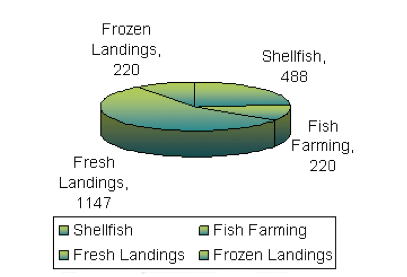
The most popular seafood groups produced in 2008 were finfish, shellfish, crustaceans and cephalopods as seen in figure 4 and their values in figure 5.
Figure 4.Finfish Followed by Shellfish, Largest Production by Species Group in France, 2008
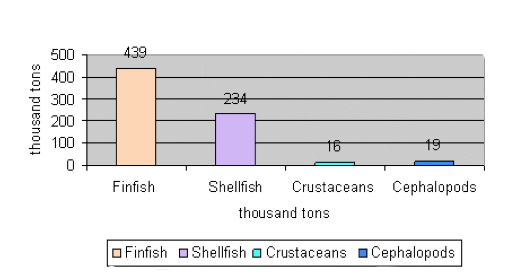
Value of Finfish Leads in Production by Species Group, 2008

Sale of Fishery Products at Auctions
Auctions are a very popular way of selling seafood in France. There were approximately 40 auctions that took place in 2009, which accounted for 186,785 tons ($656 million) in sales from French vessels and 5,345 tons ($23.18 million) in sales from foreign-registered vessels. The main species sold at auctions by French vessels included sardine, Great Atlantic Scallop, Monkfish, Whiting, Hake, Mackerel, Cuttlefish, Saithe, Sole, squid, Haddock, nephrops, seabass, and Small-spotted catshark.
Figure 6.Quantities Sold of Main Species at Auction by French vessels, 2009
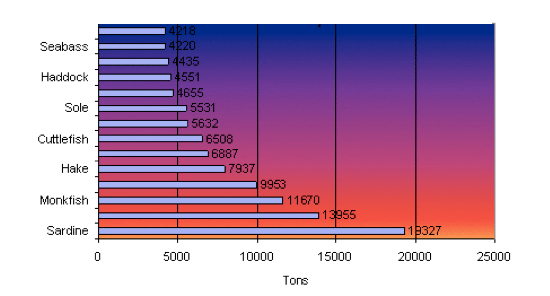
Fishery & Seafood Sector Employment
Nearly 5,250 people worked in the area of fisheries as seamen employed on board French vessels in France during 2008. There were 374 companies in the sector, grossing $2.7 billion. The mostly small companies were mainly located on the sides of the Channel and Brittany. The fish and seafood sector in France employed a number of people including seamen on board French fishing vessels.
Figure 7.Seaman Employed on Board French Fishing Vessels, 2008

TRADE
Salmon: A Leader Among Seafood Imports to France
France imported $912 million of salmon in 2009. Figure 7 shows the main species of seafood imported and their values.
Figure 8.Imports to France of Main Species Seafood, 2008
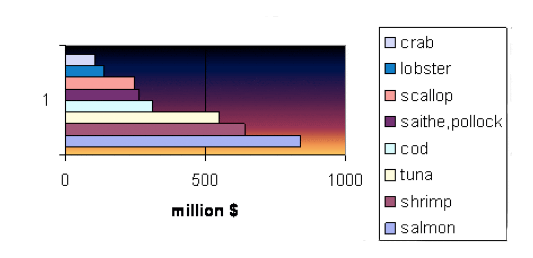
CONSUMPTION
Salmon is one of France’s favorite finfish and is it consumed fresh, frozen, and smoked. As France has one of the highest salmon consumption rates in Europe, it relies heavily on imports. Groundfish fillets are also popular in the French retail sector in whole, cuts, fresh or frozen formats. In 2009, a number of groundfish resources showed stable signs of recovery, after several rather bleak years.
The frozen groundfish fillets market showed an increase from 128,600 tons to 135,900 tons in 2009 compared with lower levels in 2008, but has not yet recovered to the high 2007 levels. The 2009 rise reflected increased imports by the United States, not only of frozen fillets but in particular, an increase in imports of blocks. More specifically during this period, the quantity of frozen groundfish fillets imported from the United States was 89,200 tons, only 3 per cent more than in 2008, whereas imports of blocks went up by 11 per cent, reaching 46,700 tons the same year.
There is also a clientele in the French market that consumes luxury shellfish such as spiny lobster, lobster, scampi, and large prawns. For lobster, French catches are limited to about 300 tons per year, though the market is much larger. The main market is mid to high-end restaurants, with peak consumption in December 2009. In this market, Canada is the main competitor for US lobster. Canada benefits in the market because of improved air connections with France and less expensive freight prices thus preferred transportation methods.
Household's Spend A Lot on chilled products in France, 2009
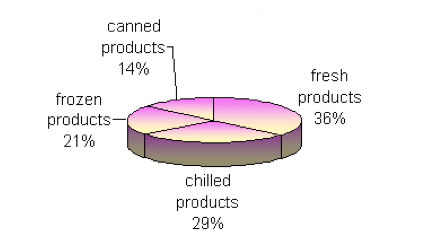
French consumers are more inclined to purchase aquatic products in supermarkets rather than markets or fishmongers. For fresh products, 68 per cent are purchased from supermarkets, 15 per cent from other markets, and 12 per cent from fishmongers. For canned products, 81 per cent are purchased from supermarkets and 17 per cent from hard discount. Eighty-four per cent of chilled delicatessen products are purchased from supermarkets, while 10 per cent are purchased from hard discount stores, and 3 per cent from fishmongers and markets. Lastly, fifty per cent of frozen products are purchased from supermarkets while 37 per cent are purchased from freezer centers or delivered to the home and 13 per cent are purchased from fishmongers and markets.
MARKETING
US Seafood Cooperators in France: What’s Happening on in the Market?
In France, the Alaska Seafood Marketing Institute (ASMI) promotes US wild salmon, surimi, and Alaskan pollock. Additionally, ASMI promotes seafood sustainability as well as healthy seafood. ASMI has successful foodservice promotion in France, especially since working with Flunch, one of France’s largest cafeteria chains. An eight-day promotion at the chain's 216 self-service restaurants reached on average 210,000 consumers per day in 2009. Sales of Alaska salmon increased 233 per cent during this promotion, and other popular chain's use of Alaska salmon throughout the year has grown significantly.
Food Export USA Northeast is a non-profit organization that promotes exportation of food and agricultural products from the northeast region of the United States. This organization helps exporters of northeast food and agricultural products sell their products overseas. Food Export USA, in conjunction with its member states, provides a wide range of services to facilitate trade between local food companies and importers around the world. These services include: export promotion, customized export assistance, and a cost-share funding program.
Production Outlook for 2010
In this year, the fish season was two weeks late, hence 2010’s projections being lower than average. The market will have less seafood products from the United States this year because of the low supply for fisheries and seafood. Demand for seafood has continually been increasing. Consequently, imports will be down with respect to the United States. A problem that may arise from this issue is prices of seafood will increase due to decreased supplies, and consumers may decide to switch from those higher-priced foods to cheaper ones.
ASMI calculated its 2010 salmon projections to be a harvest of 137 million fish, which is below the 10-year average of 167 million fish. However, this projection still ranks among the top 20 salmon harvests since 1900. Sockeye is projected for a harvest at 45 million fish; pink salmon at 69 million fish; chum at 17.9 million fish; and salmon roe at 19 to 20 million pounds.
Norway is the largest competitor of the United States for salmon and cod because of the use farming techniques for harvesting fishes making the availability of increased quantities possible throughout the year. Scotland is a largest competitor for salmon; Russia for Alaskan Polluck; France for lobster; and France and Ireland for scallop.
Interestingly, China is a competitor of US product – due to labeling. Frequently, the United States ships seafood products, such as salmon, to China for further processing (i.e. cutting salmon into fillets). Once production is complete, it is then shipped to France, where it is often labeled as a product of China. This happens most often for salmon and polluck fillets.
Marketing Development: Enhancing the US Market
The United States has a strong presence in France’s seafood market, yet there are ways in which the US presence can be made stronger. The French market is increasing its demand for products that are MSC certified. Continuing to certify US seafood will help US products permeate the French market. Also, the United States needs better availability of products throughout the year. Continuing to build in production capacity will help the United States’ ability to export to France. This will also help provide seafood buyers with access to products from the US market when desired. US exporters who are looking to sell to the French Market should consider participating in one or all of the following trade shows:
Salon International de l'Alimentation (SIAL), FranceParticipation in the official USDA-endorsed USA Pavilion at SIAL 2010 offers exhibitors the prestige and visibility of exhibiting with other US companies while keeping their own identity- an individual booth with a cost-effective, complete service package eliminating language barriers, communication lag-time and currency transfers.
European Seafood Exposition, BrusselsThe European Seafood Exposition is the leading seafood show in Europe. It takes place every year in Brussels, Belgium. The European Seafood Exposition is the world's largest seafood fair. Attracting buyers and sellers from over 140 countries around the world and featuring the stands of over 1600 exhibitors, the European Seafood Exposition is the global can't-miss fair for the seafood industry. The next exposition will be held on May 3-5, 2011.
SIRHA (International Hotel Catering and Food Trade Exhibition), FranceSIRHA is the global hotel and food service trade show. It is the premier international forum for Hotel, Restaurant, and Institution Food Service Sector. It is also the international meeting place for chefs and other food professionals. Participation in this outstanding event would allow you to take advantage of the world’s finest setting to showcase your creativity to the people who matter for your business. It is also a USDA-endorsed show with a US Pavilion. The exhibition showcases quality food and food ingredient products as well as foodservice equipment and industry innovation. The show, closely linked to Chicago’s National Restaurant Association Trade Show, is also host of the world famous “Bocuse d’Or’ and the World Pastry Cup culinary competition. The next show will take place January 22-16, 2011 in Eurexpo Lyon, France.
The Consumer’s PerspectiveEducating the public about US seafood is very important. Other than salmon, French consumers are not aware of many other seafood products from Alaska. One major issue that the cooperators have dealt with in the past as well as currently are consumers mis-perception of the origin of lobsters. Consumers assume that all lobsters sold are of Canadian origin when the majority of them are from Alaska. This is thought to be due to the fact that Alaska is a very remote place. A second reason is because though frozen lobster is labeled as from Alaska, and often time, fresh lobster is not labeled. Lastly, production companies of lobster which are located in the United States also have companies in Canada and can be misunderstood as products coming from Canada. ASMI does a lot of promotion to help deter this misconception however it continues to be problematic.
DistributionAlaska products are generally not sold through auctions. Fresh lobster and scallops are normally ordered and distributed through whole markets who then sale to supermarkets and other grocery stores. Frozen products that are packaged in containers must be repacked by retailers, and properly labeled with zoning information, weight, and origin information. Many products, because of ASMI’s push for frozen products, are moving towards value-added packing, making the repacking process quite imperative.
Gulf Oil Spill: Not much Impact on French Imports from the United StatesThe United States is only a minor presence France’s shrimp market, as seen by its 63rd ranking for imports into the country. Out of France’s 143 million tons of shrimp imported, only 60 tons was from the United States in 2009. France shrimp imports are mainly from Ecuador and India. Imports from the United States, however, increased from 38 tons in 2008 to 60 tons in 2009. Nevertheless, in the last six years, not more than 98 tons of shrimp has been imported from the United States into France in any given year. With the United States’ drastic decline in their shrimp market and available quantities for exports, it is possible that France may feel a slight decline in shrimp imports due to the perception that US shrimp may not be safe to consume, however this is very unlikely.
Seafood Import Certification RequirementsFrance’s seafood and fisheries import regulations are mostly guided by EU import conditions and regulations except for certain foods including crayfish. The European Commission’s DG SANCO mission is to guarantee that imports are safe. Import rules for these products are harmonized, meaning the same rules apply in all EU member states. Products that are subject to restrictive regulations are subject to EU quality norms and must be inspected at the point of entry, as with crayfish. A regulation established in 1985 allows only four species of crayfish to be imported into France, none of which are available from the United States.
Importation of fishery products into the European Union is subject to official certification, which is based on recognition of the competent authority of the non-EU country by the European Commission. Formal recognition of the reliability of the competent authority is a pre-requisite for the country to be eligible and authorized to export to the European Union. Public authorities with the necessary legal powers and resources must ensure credible inspection and controls throughout the production chain, which cover all relevant aspects of hygiene, public health, and in the case of aquaculture products, animal health. All bilateral negotiations and other relevant dialogue concerning imports of fishery products must be undertaken by the national competent authority. All other interested parties and private businesses wishing to export to the EU should contact their competent authority and communicate with the European Union via this channel.
Fishery and aquaculture products offered for retail sale in the EU must be properly labeled providing the following information:
- Commercial name of the species (each member state has established a list of commercial designations).
- Product method: “Caught in”, “caught in freshwater”, “farmed” or “cultivated”.
- Catch area: for products caught at sea, a reference to one of the areas listen in the annex; for products caught in freshwater, a reference to the country of origin; for farmed products, a reference to the country in which the product undergoes the final development stage.
BAN OF US BIVALVE MOLLUSCKS
Beginning July 1, 2010, a European Commission Regulation allowing importation of live and fresh molluscan shellfish and certain marine invertebrates from the US expired. This ban includes roe-on scallops and oysters however, it does not include wild caught products. This ban halts these products from being imported into the EU. Until the products are again allowed to enter, NOAA Seafood Inspection Program will not issue export health certificates for these products. The regulation includes live and fresh bivalve mollusks, echinoderms, tunicates, and marine gastropods from all states. Shellfish from the five states bordering the Gulf of Mexico are already not allowed into the EU for other reasons. Wild scallop meats, fresh or frozen, will be allowed entry; whole scallops or scallop adductor muscles with the roe attached will not be allowed. FDA and the European Union are in discussions about the reciprocal equivalency determination between the nations for shellfish. The differences have not been resolved. According to the Global Trade Atlas, the United States does not supply France with oysters. Louisiana is the largest US oyster producer and France is the largest producer of oysters in EU. France is a large important market, importing $75 million in US scallops last year.
August 2010
